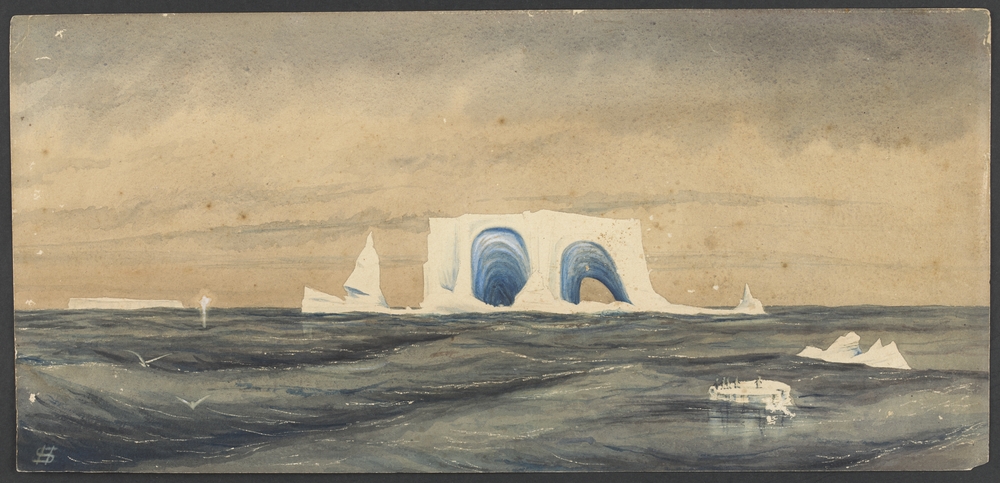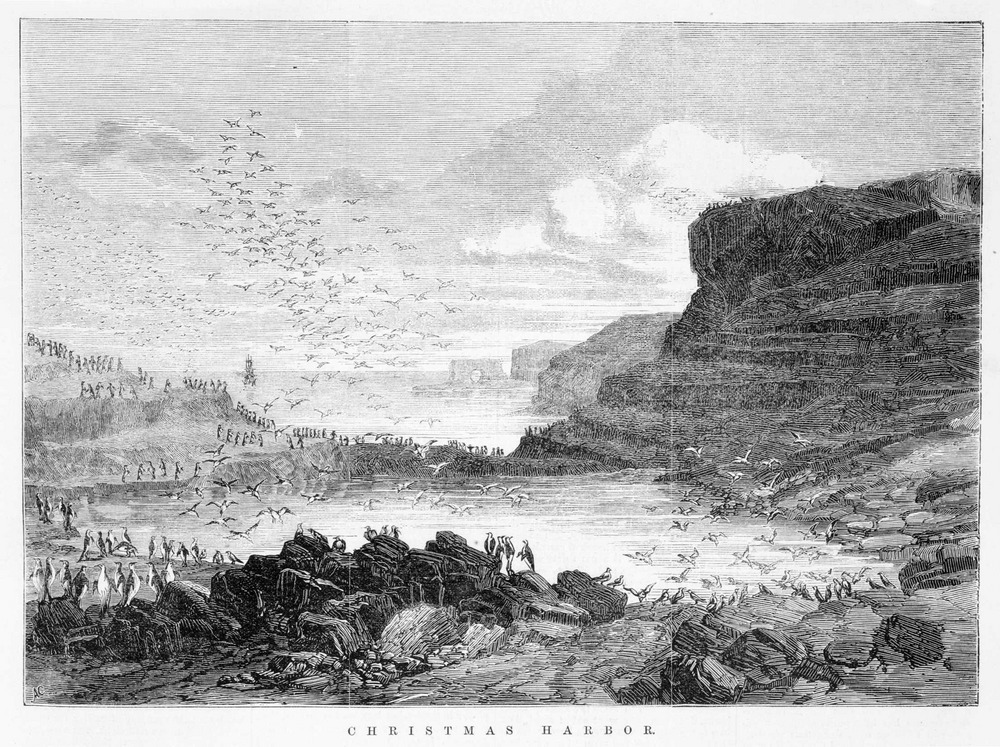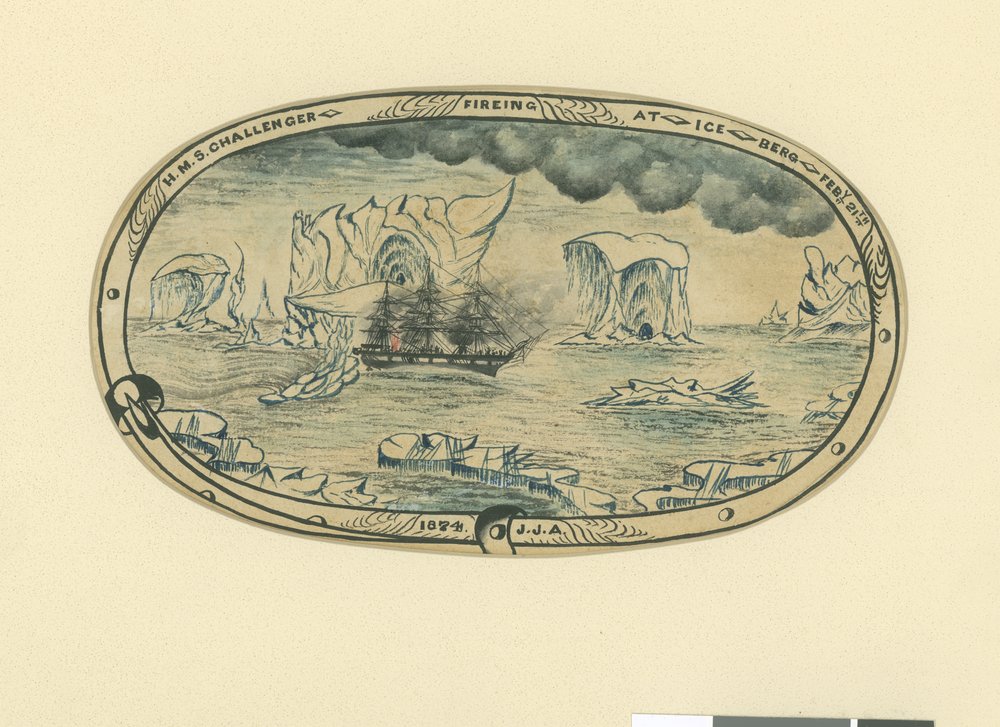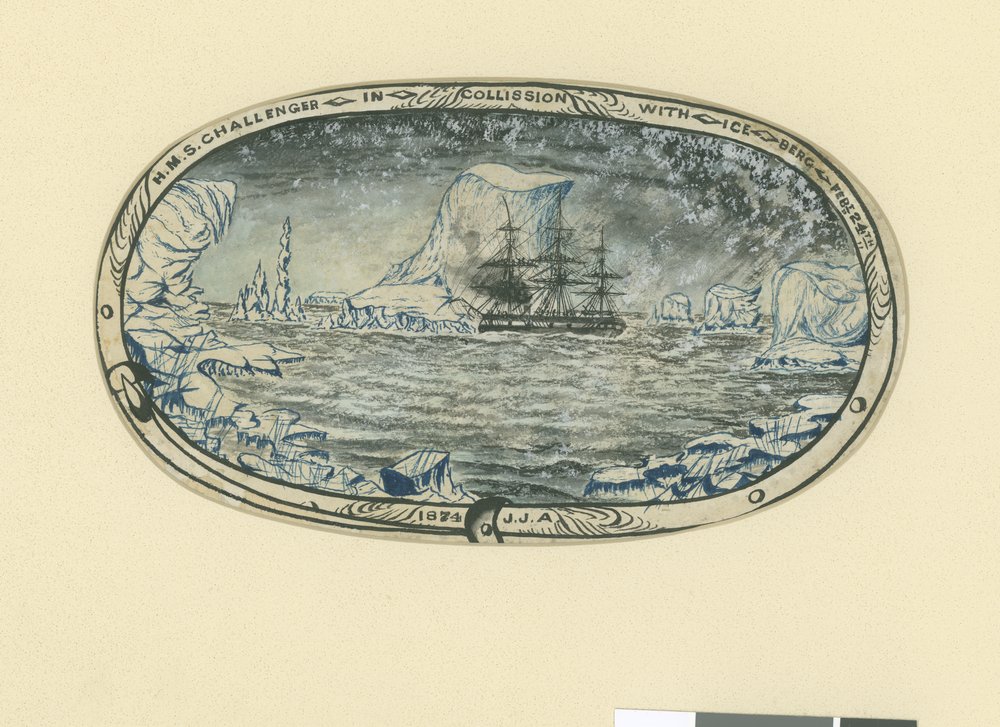Recently two watercolours by Herbert Swire (1840-1934), were donated to the library’s Pictures collection. Swire completed these delicate works while a sub-lieutenant navigator on HMS Challenger. Pictures manager Madeleine Say tells us more in her guest blog this week.
In 1872 the Challenger left Portsmouth on a scientific expedition to circumnavigate the globe and collect data on sea temperature, depth and composition. The findings from the voyage founded the sciences of oceanography and marine geology.
 The H.M.S. Challenger in the Southern Ocean. Watercolour on paper by Herbert Swire; H2017.82/2
The H.M.S. Challenger in the Southern Ocean. Watercolour on paper by Herbert Swire; H2017.82/2
Swire was 22 years old when the ship left Britain. He served on her until the Challenger reached South America in 1876, when he was invalided home. At the time of his death in 1934 he was the last remaining survivor from the crew. His private journal of the voyage was published after his death in a limited edition by the Cockrell Press, with a forward by his son Roger Swire.
The book is liberally illustrated with Swires’ drawings and watercolours. However, the section relating to Challenger’s voyage to the Southern Ocean has only simple line drawings.
Swire’s journal describes in some detail encounters with icebergs when Challenger entered Antarctic waters in February 1874. This diary entry shows how the first sightings of ice caused great excitement among the crew:
Wednesday, 11 February. Our first iceberg was in sight at daylight, being discovered to the southward, and created quite a sensation, some fellows who had not seen ice before being even energetic enough to leave their warm beds at that unearthly hour to see it.
 Ice floes on choppy water. Watercolour on paper by Herbert Swire; H2017.82/1
Ice floes on choppy water. Watercolour on paper by Herbert Swire; H2017.82/1
Two days later Swire describes the another encounter:
Friday, 13 February … The great event was, however, the passing of a magnificent iceberg. This happened just at dinner time in the evening, and notwithstanding a sharp fall of snow a good many of us mustered to see it. It was about 150 feet high by 500 feet long, and its pinnacles, cliffs, chasms, and cerulean caves defy description, the only way in which I can describe it being by likening it to one of those gorgeous Christmas transformation scenes at a first-class London theatre, which, glowing in dazzling whiteness and heavenly blue, call up visions of fairyland such as I thought then I should never see realized, till now, in looking at this scene, I see the poor tinsel and blue light of the theatre infinitely surpassed by nature’s own transformation of water into ice.
… these icebergs are really magnificent, having the most enchanting blues imaginable, from the palest cobalt to the deepest indigo, set in a framework of the purest of whites. One of them was of the finest we have seen, both for its great size (it must have been ¼ mile long by 150 feet high) and for the deep blue tints in three caves. … We have since seen even a finer one, but I reserve it to try my brush upon whenever I can get time. …I have great doubts if we make anything more to the south, as the Captain does not intend to enter the pack, the ship not being strengthened to resist ice pressure.
Swire must have found time to take up his paintbrush after his duties were completed for the day, as the watercolour Ice floes on choppy waters (above) has the inscription of ‘Feb. 14 1874 9pm’ on the reverse.
The other watercolour (HMS Challenger in the Southern Ocean, above) is dated Monday Feb 16th 2.30 pm, and as Swire relates in his journal:
Monday, 16 February, 1874. At Sea. We have been inside the Antarctic Circle and are now out of it again and standing away to the north. …All the forenoon we lay almost becalmed, surrounded by icebergs innumerable; one, a rather small one, was perfectly blue all over except on its top, which was coated with snow; the colour was that of a dark turquoise, the berg being evidently composed entirely of water ice, without any snow ice about it at all.
 Visit of the H.M.S. Challenger to Kerguelen Island; IAN20/04/74/61a
Visit of the H.M.S. Challenger to Kerguelen Island; IAN20/04/74/61a
Swire also records encounters with the wildlife that feature in his watercolours:
…we tacked round a block of ice upon which a crowd of small penguins were sitting, and who speedily took to the water when they discovered our jib boom over their heads…
The delights of the Southern ocean quickly waned, only a few days later Swire is heartily sick of the floating ice:
Friday, 20th February. Light S.E. and southerly winds which did not help us along much. Lots of icebergs around us, of which we are getting tired. I had quite enough of icebergs to last me the remainder of my life.
 H.M.S. Challenger firing at the ice berg, Feby. 21. Drawing by John Arthur; H31459
H.M.S. Challenger firing at the ice berg, Feby. 21. Drawing by John Arthur; H31459
The next day Swire reports that ‘this ice work is getting very monotonous.’ He relates how the crew started to argue about the size of a passing iceberg, and began to pelt rocks at it to determine how far away it was. Then, in the spirit of scientific inquiry, they fired a shot from one of the ships’ 12 pound Armstrong guns into a passing berg.
For the crew who had been at sea for over three months, it was a tedious time. It was, of course, incredibly cold, and the crew were aware food was running short. The voyage north was slow. On the 25th February the ship collided with an iceberg, breaking the jib boom:
Our position was now unenviable in the extreme. Surrounded by bergs driving before the wind, and without knowing the whereabouts of any of them, we might at any moment be dashed against the face and jagged teeth of these loosed giants of the deep. ….
 H.M.S. Challenger in collision with ice berg, Feby. 24th. Drawing by John Arthur; H31463
H.M.S. Challenger in collision with ice berg, Feby. 24th. Drawing by John Arthur; H31463
Eventually the Challenger made it to open water and arrived in Melbourne on 17th March. After a fortnight stay the Challenger sailed on for Sydney, arriving at Port Jackson on 1st April 1874. Here Swire contacted his uncle Ned (Edward) Swire, who had emigrated to New South Wales.
The Challenger spent a month in Sydney, allowing Swire to make several trips ‘up country’ to visit his uncle’s connections in the Hunter Valley, and to play cricket in Bathurst.
Herbert Swire gave the watercolours to his colonial relatives, and they remained with the family until their recent donation to the library by the great granddaughter of Edward Swire.
References
Swire, H., 1938, The voyage of the Challenger : A personal narrative of the historic circumnavigation of the globe in the years 1872-1876


Fascinating Paul, guess they were lucky to survive in such unknown waters.
How wonderful of the family to donate the paintings to the SLV 🙂
Many thanks to the SLV for the warm acceptance of the 2 paintings by Herbert Swire who gave them to my great grandfather Edward Swire (his uncle) when the sailing ship Challenger visited Sydney in 1874 soon after its voyage into the Southern Ocean. Young Herbert (age 22) was a Royal Navy navigation officer on the voyage – resilience and skill led to survival as a “matter of course” in uncharted waters for the young RN officers. And they had such fun! Am very proud to donate them to the Slv after so many years in my family hidden away from public view
Google Corfield, The Silent Landscape…. for more info
Willys Keeble
Thank you for sharing this story. Will these works be available to see at the SLV. It is wonderful to see the watercolours. I noticed the date “arriving at Port Jackson on 1st April 1974” in the print.
Hi Kirsten,
Thanks for your comments. The Swire watercolours aren’t on public display but as they have been digitised at 300 DPI- you can download them for free as tiffs or jpegs.
Paul
Herbert’s Journal can be Downloaded @ The University of Wollongong Library, Archives.
https://archivesonline.uow.edu.au/nodes/view/7323